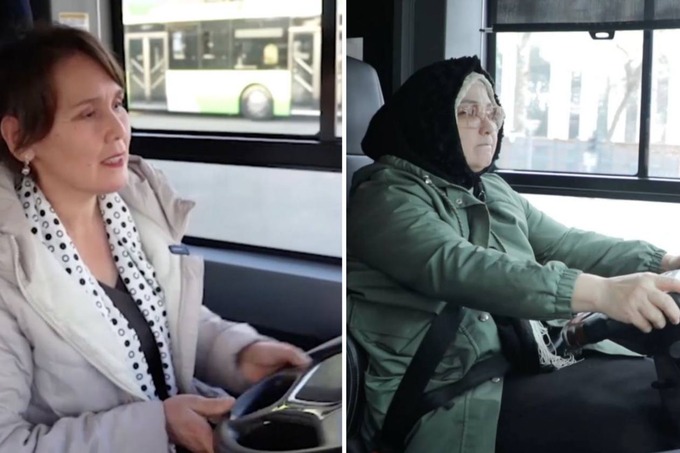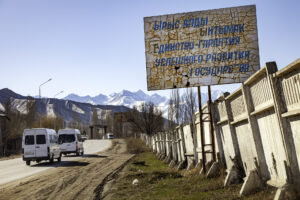A recent change in the law allows women to drive buses and heavy vehicles in Uzbekistan. This is a significant step forward for Uzbekistan’s transportation industry, a demonstration of active dedication to promote gender equality and diversity in the industry.
Nargiz Gadayeva and Saodat Shermatova showed interest in becoming the country’s first female bus drivers – and, according to the Tashkent transport company, these women have been granted official permission to drive large-capacity buses and electric vehicles.
Saodat Shermatova
On February 28, Saodat Shermatova, a 49-year-old woman from Samarkand and a mother of two, took the bus driver’s seat for the first time in her life. She has been interested in transportation industry since her teenage years, although she studied law to follow her father’s footsteps.
“There were no women drivers in our family, so I had to be the first,” says Saodat. In 2005, she obtained a category D driving license, which allows her to drive a bus with more than 8 passengers. Saodat’s husband was “worried about safety issues” when she decided to apply for the position – but still decided to support his wife in her endeavors to make it easier for her to complete a mandatory one-month training program for female drivers.
Nargiz Gadayeva
Nargiz Gadayeva, a 57-year-old woman from Qarshi, joined the training program right after Saodat. She started driving when she was twenty and has been working as a driving instructor for ten years. Her colleagues encouraged her to become one of the first female bus drivers in Uzbekistan.
“When I told my family members about it, they thought I was kidding”, says Nargiz. “Only after my first working day did they start worrying more about me.”
Initially, she was interested in working in tourism, but after the changes in the law, she became determined to pursue a career in bus driving.
“I want to be an example for other women in Uzbekistan. Women are capable of many things as long as we work hard and have perseverance,” says Nargiz.
In the history of Uzbekistan, there have been numerous examples of women-pioneers who decided to pursue spheres formerly dominated by men. One of the prominent examples is Bashorat Mirboboyeva, the first woman to start operating a locomotive. Together with the other 26 women, she applied to the railway courses that were organized by the Tashkent official railway institution and later worked delivering supplies to the frontline. After World War II, she switched to a diesel engine and became the first woman in the USSR to enter this field.
Another example is Tursunoi Akhunova, the first female driver of a cotton harvester. She was also the brigade foreman at the collective farm. With her commitment, productivity increased greatly over the years, which also brought her two Hero of Socialist Labour titles – the highest degree of distinction in the Soviet Union for exceptional achievements in industry and culture.
On the way to gender equality
Azizakhon Khodjayeva is responsible for the gender equality project in the Transportation Authority. She believes that the law made Uzbekistan one step closer to eliminating gender-based stereotypes. The two women are working full-time, driving for eight hours every day, and it is planned to hire another fifteen female drivers next year.
Before the law was changed, many Uzbek women left the country to work as drivers in Russia, which also meant having a reasonable salary. Legal restrictions did not allow women to drive buses, which is why they had to leave their families home and go abroad in search for opportunities.
Read more on Novastan: Uzbekistan: when women demand to have a voice
According to the World Bank’s 2022 Women, Business, and the Law research, Uzbekistan scored 70.6 out of 100, with 100 representing equal legal status for men and women in the labour market. Among other Central Asian countries, Kazakhstan scored 69.4, while Tajikistan got 78.8.
This score can partially be attributed to the Soviet Union legacy – in Uzbekistan, as well as in Kazakhstan, Tajikistan, and Kyrgyzstan, there is a list of professions that are banned for women. This list has been created in 1978 in the USSR and included 431 professions; some of them migrated to the laws and labour codes of the independent republics after the Soviet Union collapsed. In Uzbekistan, this list consisted of 44 professions that were deemed harmful or dangerous for women, such as mining or metallurgy. In 2019, the list was terminated by the presidential decree, although the professions are still listed in the labour code.
Darika Bolot and Shakhzoda Mirakova for Novastan
For more news and analysis from Central Asia, follow us on Twitter, Facebook, Telegram, Linkedin or Instagram.
 Hitting the road: the first female bus drivers in Uzbekistan
Hitting the road: the first female bus drivers in Uzbekistan 



